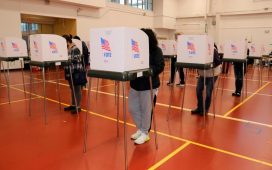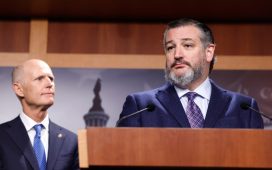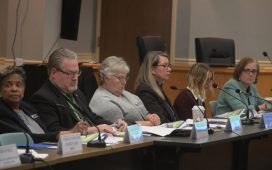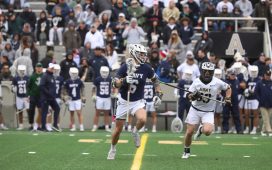Hip 149, a Tapit filly out of Embellish the Lace, topped the opening session of the 2020 Keeneland September Yearling Sale.
Given the amount of uncertainty surrounding the world’s economy, and the microcosm of it that is the Thoroughbred marketplace, the 2020 renewal of the Keeneland September Yearling Sale had the widest range of plausible outcomes of any major North American sale in recent memory.
In a best-case scenario, the market hunkers down and keeps up the momentum that has repeatedly set records over the past decade, looking ahead to a future when the horses in the ring are running or breeding, and COVID-19 is hopefully in the books.
In a worst-case scenario, a marketplace already showing signs of being wobbly at the wheels before the pandemic gets abandoned by everyone but the most financially secure, and the bottom drops out before the sale even reaches its second week, bringing back that sinking feeling from the crash of the late 2000s.
What actually transpired was a little bit of both.
The numbers were down across the board, as expected, and someone seeking reasons for long-term concern would have no trouble finding them. The market was polarized to an even greater degree than the already fickle previous years, as evidenced by this year’s higher buyback rate, and the overall number of horses sold versus the number cataloged.
However, that polarization also meant the pockets of the market where buyers retreated remained solid-to-strong. The number of seven-figure horses (15) was still the fourth-highest since the bottoming-out of 2010, and comments from both buyers and sellers noted that bidding remained competitive into the later books for the horses that were coveted by that section of the market. This wasn’t a callback to the desperate times of the recession when nobody was spending money, but the people that have the money were spending it differently and more carefully.
If your horse had the right pedigree and physical for its spot in the catalog, chances were good it was met with a fair price. Anything less had some hard truths to face, and this dictated the narrative for the sale from the first session.
“I didn’t really want to be right, but we expected the market to be down about 30 percent overall, and I think that’s about what happened,” said Meg Levy of Bluewater Sales. “It seemed to be all or nothing. I saw more polarization than there has been. I saw big, special, physical colts tend to sell better than fillies overall. Even people with smaller budgets, the target has gotten a lot smaller as far as what everyone’s looking for. Whether they have a million dollars or $100,000, they’re looking for the same individual.”
This year’s 12-day Keeneland September sale finished with 2,346 horses sold for revenues of $238,454,300, down 36 percent from last year’s gross of $372,348,400 from 2,974 horses sold.The average and median sale prices were each down 19 percent to $101,643 and $37,000, respectively.
This year’s gross marked the lowest return since 2012, when 1,362 yearlings sold for $226,667,500.
It was also the sharpest single-year decline in gross since the drop from 2008 to 2009, when revenues fell 39.6 percent, from $327,199,100 in 2008 to $198,055,200 the following year. The stock market crash of 2008 happened in the middle of that year’s sale, and the full effect of the economic recession was felt the following year.
The bulk figures also took a hit in terms of the horses that sold and didn’t sell. The RNA rate finished at 29 percent compared with 24 percent last year. Combining outs and RNAs, 42 percent of the horses cataloged in this year’s sale did not change hands either in the ring or privately afterward. In 2019, that figure was 36 percent.
The attrition rate is often rather high in the later books, when sellers look at their non-commercial horses and decide to leave them on the farm. One thing that stood out about this year’s sale was the “not sold” rate in the select Book 1. Of the 448 horses cataloged over the two-day portion, 49 percent of them were either scratched or didn’t meet their reserve, with no private sale recorded thus far on the Keeneland website. Last year’s first book, spanning three sessions, only saw 35 percent of its 569 cataloged offerings fail to change hands.
There are plenty of reasons for this shift in the upper marketplace, beyond the obvious ones surrounding the economy and the pandemic.
Sheikh Mohammed Al-Maktoum of Godolphin, a driver of commerce at the top of the market, was absent in person and on the buyer line at this year’s sale. Shadwell Estate Co., owned by Sheikh Hamdan Al-Maktoum, was present, and it secured one seven-figure horse, but the operation did not buy with its usual high-end vigor seen in previous years.
Among the big-time buyers that remained, many elected to team up on big horses, instead of fighting amongst themselves. The $2-million sale-topper by Tapit was purchased by Eclipse Thoroughbred Partners, Robert LaPenta, Gainesway, and Winchell Thoroughbreds, while breeder Stonestreet Farm remained in for a piece after the sale. Earlier, the team of Mike Repole, St. Elias Stable, Gainesway, John Oxley, and Grandview went in together on a $1.2-million Curlin colt.
When a quintet of buyers who are typically reliable competitors from the $250,000-to-$1 million range pool their resources on one horse to the tune of $400,000 each for the $2-million topper – assuming the horse is divided evenly five ways – this leaves potential gaps a rung or two down the ladder on the buyer line. The aforementioned purchases alone turned 10 potential upper-level transactions into two.
This ripple effect was felt all the way into the middle books, when it came to how many hands were going up for horses, and whose hands they were.
“In years past, I might have been on six, seven, eight [horses] before I got one,” said bloodstock agent Marc Wampler, who started shopping in Book 3 for Pocket Aces Racing. “I was going up there and I knew I might not even get my hand up, but I’d eventually get something done. It was probably two or three horses this year.”
Wampler landed two first-crop yearlings for Pocket Aces at this year’s Keeneland September sale for a total of $45,000. In previous years, he said either of his purchases could have commanded that amount on their own. With that being said, he felt he’d benefitted from a market that turned cold on a rapidly-expanding group of “have nots.” If there’s competition, it will be fierce and deep-pocketed. If there’s not, bargains are there to be had.
“On the nice ones, you’ve just got no hope on them,” he said. “We go up there with a budget, thinking we’ll spend X-amount of dollars on certain horses, and we feel like the competition, they just don’t even have a budget. They’re just going to go get the horse. We all land on the same horses, and that’s what we’re up against. I’ve got a cap where other people have the mentality of, ‘Whatever it costs, we’re bringing it home.’”
Book 1 took some of the sale’s steepest dives in terms of average and median sale prices, and that’s significant given how much of the sale’s overall returns are dictated by those opening sessions. However, the rank-and-file of the catalog held surprisingly steady.
Of the six sessions that comprise Books 4 through 6, four of them posted gains in average sale price and three showed increases in median sale price.
“The second week has been a lot stronger than I’d anticipated,” said Geoffrey Russell, Keeneland’s director of sales operations. “I think Books 3, 4, and 5, even into 6, the market has held up well.”
Russell speculated the reason for the relatively solid mid-to-low-end market had to do with the intention of the purchase. A horse bought in the opening sessions is done with residual value in mind, eyeing big returns as a stallion or broodmare prospect that would be almost impossible to recoup strictly on the racetrack. With a lower entry point comes a lower threshold to make money.
On the other side of the transaction, blue-collar breeders and sellers might not have the means to hang on to a horse and race them if the price isn’t right in the ring, forcing their hand to move the product and set a lower reserve, even if it’s not at the margin they’d like.
“At a certain price, a horse has great value in its return on investment,” Russell said. “Racing is doing well, purse structures are doing well, so there is potential to get a good return. In the middle markets, they’re really buying the product to race and get a return on the investment. I think at the moment, we can still do that on the racetrack.”
Even in that level of the market, though, the margin for error in the eyes of the buyer was slim, especially for the pinhook contingent. The group had to reload for whatever 2021 might bring after a 2020 juvenile sale calendar that saw myriad cancellations, postponements, and gnashed teeth due to COVID-19, while also getting into the mind of what a buyer in next year’s murky climate might want.
“There’s less money in circulation,” said Kip Elser of Kirkwood Stables. “The perceived top on any given day held up very well. It was a real struggle for some farmers to sell their crop, and it was as picky as the market has gotten. It was very difficult for pinhookers to buy horses that a couple years ago, you might have been able to take a little bit of a fault here and a fault there, but pinhookers have to buy looking at the next buyer’s criteria, and that has narrowed the field again. There are plenty of good horses with a minor fault here or that that did not reach full value that will be successful racehorses.”
For many at the sale, it seemed as though success came on a case-by-case basis. The numbers were down, but there were victories in some unexpected places that carried at least a few of the defeats.
When the yearling market was watching the juvenile market try to navigate this summer’s uncharted waters, anything on the spectrum of expectations for the fall seemed both far-flung and realistic. Even in a market as volatile as it’s been in a decade, there was still a mild sense of relief that horses were being traded at all.
“I think if we knew now what we didn’t know three weeks ago, that it’s going to be off that amount, I think we would have signed up for it all day long,” said Zach Madden of Buckland Sales Agency. “Especially in June and July, when COVID was going nuts, and everything else going on just rolled into one. I don’t know how everyone else feels, but I just feel fortunate to be over here, and not just pounding my head against the pavement.”
History has proven that the market is cyclical, and with such a sudden and unexpected shot across the bow like COVID-19 and its complications, it’s hard to determine just what the ramifications of the past two weeks will be. A quick and effective vaccine and a steady economy might make this a brief hiccup, or it might be the tipping point for a full-blown market downturn regardless of the world’s situation. Or, like this year’s sale, it might be a little bit of it all.
Until there’s a solid answer, most will remain in a holding pattern.
“I don’t think pinhookers have as much money to spend or as much confidence in what next year’s market is going to be,” Elser said. “I think if there was real confidence in next year’s market, they would have found the money in some fashion, but I don’t see brimming confidence in next year. I don’t think anybody’s predicting disaster, but I don’t think people are predicting a big, huge rebound. I think we’ll probably hit bottom and start incrementally growing again.”
New to the Paulick Report? Click here to sign up for our daily email newsletter to keep up on this and other stories happening in the Thoroughbred industry.
Copyright © 2020 Paulick Report.








